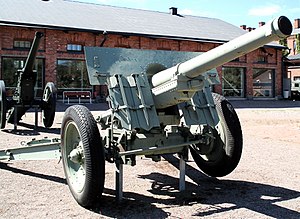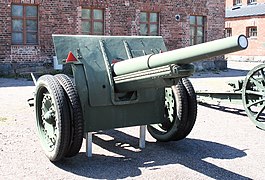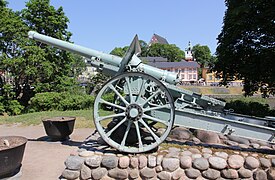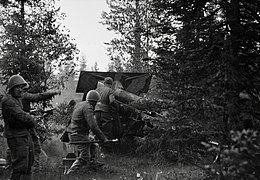
The 76 mm Mountain Gun Model 1909 was a rapid-fire mountain gun based on the Schneider-Danglis mountain gun that was used by the Imperial Russian Army during World War I and the Red Army during World War II

The French 75 mm field gun was a quick-firing field artillery piece adopted in March 1898. Its official French designation was: Matériel de 75 mm Mle 1897. It was commonly known as the French 75, simply the 75 and Soixante-Quinze. The French 75 was designed as an anti-personnel weapon system for delivering large volumes of time-fused shrapnel shells on enemy troops advancing in the open. After 1915 and the onset of trench warfare, other types of battlefield use demanding impact-detonated high-explosive shells prevailed. By 1918 the 75s became the main agents of delivery for toxic gas shells. The 75s also became widely used as truck mounted anti-aircraft artillery. They were the main armament of the Saint-Chamond tank in 1918.
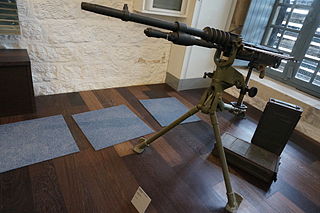
The Mle 1914 Hotchkiss machine gun chambered for the 8mm Lebel cartridge became the standard machine gun of the French Army during the latter half of World War I. It was manufactured by the French arms company Hotchkiss et Cie, which had been established in the 1860s by American industrialist Benjamin B. Hotchkiss. The gas-actuated Hotchkiss system was first formulated in 1893 by Odkolek von Ujezda and improved into its final form by Hotchkiss armament engineers, American Laurence Benét and his French assistant Henri Mercié.

Ckm wz. 30 is a Polish-made clone of the American Browning M1917 heavy machine gun. Produced with various modifications such as greater caliber, longer barrel and adjustable sighting device, it was an improved although unlicensed copy of its predecessor, and was the standard machine gun of the Polish Army from 1931.

The 152 mm howitzer-gun M1937 (ML-20), is a Soviet heavy gun-howitzer. The gun was developed by the design bureau of the plant no 172, headed by F. F. Petrov, as a deep upgrade of the 152-mm gun M1910/34, in turn based on the 152-mm siege gun M1910, a pre-World War I design by Schneider. It was in production from 1937 to 1946. The ML-20 saw action in World War II, mainly as a corps / army level artillery piece of the Soviet Army. Captured guns were employed by Wehrmacht and the Finnish Army. Post World War II, the ML-20 saw combat in numerous conflicts during the mid to late twentieth century.

The 76.2 mm divisional gun model 1902 was a Russian light field gun used in the Russo-Japanese War, World War I, the Russian Civil War, and a number of interwar armed conflicts with participants from the former Russian Empire. Modernized versions of this gun were employed at the early stage of World War II.

The Mortier de 280 TR Modèle 1914 Schneider was a French siege howitzer manufactured by the Schneider et Cie company, used during World War I. The howitzer had its origins from a Russian Army policy to upgrade its artillery park after the poor showing of Russian artillery in the 1904-5 Russo-Japanese war. In 1909 an agreement was signed between Schneider and the Russian armaments manufacturer Putilov to jointly develop and produce a number of artillery types. One of these types was a 279.4 mm (11-inch) siege howitzer with a range of 6,000 m (20,000 ft) to replace very old Russian guns of similar calibre. Schneider delivered the first prototype of the siege howitzer to the Russians in 1912 for extensive testing. Although the Russians found the gun was unable to penetrate the heaviest reinforced concrete fortifications its general performance was judged satisfactory which led to an order for 16 howitzers to be delivered in 1915. The French Army expressed interest in the Schneider howitzer as a possible replacement for the Mortier de 370 Mle 1885 De Bange. After some dithering by French authorities 18 howitzers were ordered in 1913. Delivery of the howitzers to Russia and France was delayed by the general mobilisation of 1914 which disrupted industrial production. During the war 126 howitzers were delivered to the French Army and 26 to Russia as the 280 mm Schneider Mortar Model 1914/15 before the 1917 revolutions. In addition another 25 barrels were installed post-WW1 on the Saint-Chamond heavy self-propelled gun chassis as the Mortier 280 mm TR de Schneider sur affût-chenilles St Chamond.
152-mm gun model 1910/30 was a Soviet gun, a modernization of World War I era 152-mm siege gun M1910. The gun was briefly used by RKKA in the German-Soviet War.

107-mm gun model 1910 was a Russian field gun developed in the years before the First World War. It also saw service during the Russian Civil War, Winter War and Second World War. The gun was initially developed and produced by the French arms manufacturer Schneider, but was later built by the Putilovski and Obukhov plants in Saint Petersburg.

The Canon de 105 mle 1913 Schneider was a French artillery piece used in World War I and World War II by many European countries.

The Canon de 155 C modèle 1917 Schneider, often abbreviated as the C17S, was a French howitzer designed by Schneider. It was essentially the Canon de 155 C modèle 1915 Schneider fitted with a different breech to use bagged propellant rather than the cartridge cases used by the older howitzer. It was used by France, Russian Empire, Belgium, Romania, and the United States from 1917 during World War I and was widely exported after the war. Surviving weapons were in service with France, Poland, Greece, Italy, Belgium, the United States, and Finland during World War II. Captured weapons were used by the Germans for their 2nd-line artillery and coast defense units.

The Canon de 155 C modèle 1915 Saint-Chamond was a French howitzer used during World War I. It was based on a private prototype of a 150 millimetres (5.9 in) howitzer presented to the Mexican government in 1911. The French government ordered 400 Saint-Chamond howitzers in 1915, these being delivered starting in late 1916. Small numbers of Saint-Chamond howitzers were given to the Serbian and Romanian armies towards the end of World War I. The Saint-Chamond howitzer served in the French Army after World War I and were mobilised at the outbreak of World War II. Finland bought 24 Saint-Chamond howitzers during the Winter War and these served until the 1960s. The German Army captured some Saint-Chamond howitzers after the fall of France and used these mostly as coastal defence guns until the end of World War II.

The 152 mm howitzer Model 1910 Schneider or, more properly, 6 dm polevaja gaubitsa sistemy Schneidera as it was designated in Tsarist times, was a French howitzer designed by Schneider et Cie. It was used by the Russian Empire and the Soviet Union during World War I, the Polish–Soviet War and the Russian Civil War. Finland captured nine during the Finnish Civil War, but did not use them during that conflict. They did see combat during the Winter War and the Continuation War.

The Canon de 75 contre avion modèle 1940 Schneider was a French 75 mm anti-aircraft gun designed and manufactured by Schneider et Cie at Le Creusot. These guns were used by the French Army during the Second World War.

The Canon de 100 mm Modèle 1891 was a French naval gun developed in the late 1800s that armed a variety of warships before World War I and during World War II. In addition to its naval role it was also deployed as coastal artillery.

The Armata 75 mm wz.02/06 was a light field gun used by Poland before and during World War II. It began life as the 76 mm divisional gun M1902, a Russian light field gun used in the Russo-Japanese War, World War I, Russian Civil War and Polish–Soviet War.

The Canon de 75 antiaérien mle 1913–1917 were a family of French 75 mm anti-aircraft guns designed and manufactured by Schneider et Cie at Le Creusot. The guns were used by the French Army during the First World War and Second World War.
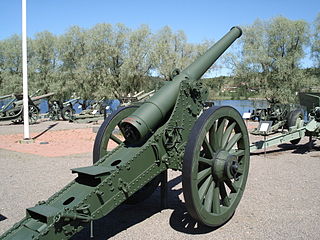
The Canon de 120 mm L modèle 1878 – was a French piece of siege and field artillery which was widely used during the First World War and despite its obsolescence, it was still in use by some nations during the Second World War.

The 120 mm Armata wz. 78/09/31 and 120 mm Armata wz. 78/10/31 were field guns produced in Poland and used by Poland during World War II and Finland during the Continuation War.
